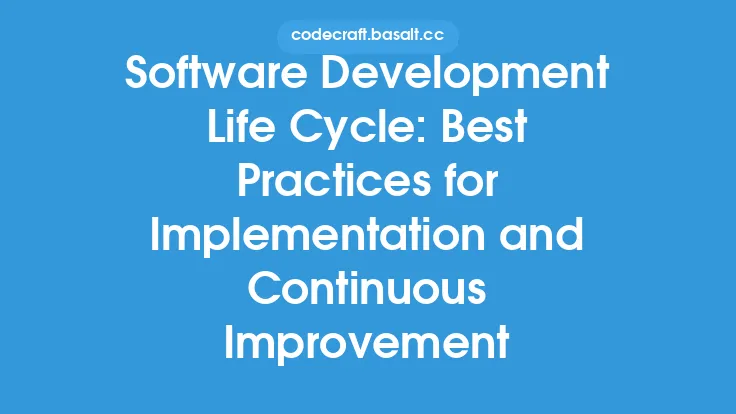When it comes to software projects, one of the most critical phases is the requirements analysis phase. This phase is where the project team works to identify, analyze, and document the requirements of the project. The goal of this phase is to ensure that the project meets the needs and expectations of the stakeholders, and that the solution developed is feasible, effective, and efficient. In this article, we will delve into the details of requirements analysis for software projects, exploring the key activities, techniques, and best practices involved.
Introduction to Requirements Analysis
Requirements analysis is a systematic process that involves identifying, analyzing, and documenting the requirements of a software project. It is a critical phase of the software development life cycle, as it lays the foundation for the entire project. During this phase, the project team works closely with stakeholders to gather and analyze requirements, identify potential issues and risks, and develop a clear understanding of what the project needs to deliver. The output of this phase is a set of well-defined, unambiguous, and testable requirements that can be used to guide the development of the software solution.
Key Activities in Requirements Analysis
There are several key activities involved in requirements analysis, including:
- Requirements gathering: This involves collecting data and information from stakeholders, users, and other relevant sources to identify the requirements of the project.
- Requirements analysis: This involves examining and interpreting the collected data to identify patterns, relationships, and inconsistencies.
- Requirements definition: This involves defining and documenting the requirements in a clear, concise, and unambiguous manner.
- Requirements validation: This involves verifying that the defined requirements are correct, complete, and consistent with the project's goals and objectives.
- Requirements prioritization: This involves prioritizing the requirements based on their importance, urgency, and feasibility.
Techniques Used in Requirements Analysis
There are several techniques used in requirements analysis, including:
- Use cases: These are scenarios that describe how the system will be used by actors (users, administrators, etc.) to achieve a specific goal.
- User stories: These are brief descriptions of the system's functionality from the user's perspective.
- Business process modeling: This involves creating diagrams and models to represent the business processes and workflows that the system will support.
- Data flow diagrams: These are graphical representations of the data flows and transformations that occur within the system.
- Entity-relationship diagrams: These are graphical representations of the data entities and their relationships.
Best Practices for Requirements Analysis
There are several best practices that can be applied to requirements analysis to ensure that it is effective and efficient. These include:
- Active stakeholder involvement: Stakeholders should be actively involved throughout the requirements analysis phase to ensure that their needs and expectations are met.
- Clear and concise documentation: Requirements should be documented in a clear, concise, and unambiguous manner to avoid misunderstandings and misinterpretations.
- Iterative and incremental approach: Requirements analysis should be performed in an iterative and incremental manner, with regular reviews and updates to ensure that the requirements are accurate and up-to-date.
- Use of standards and templates: Standards and templates can be used to ensure consistency and quality in the requirements documentation.
- Continuous validation and verification: Requirements should be continuously validated and verified throughout the project to ensure that they are correct, complete, and consistent with the project's goals and objectives.
Challenges and Pitfalls in Requirements Analysis
There are several challenges and pitfalls that can occur during requirements analysis, including:
- Incomplete or inaccurate requirements: If the requirements are not complete or accurate, it can lead to misunderstandings, misinterpretations, and errors in the developed solution.
- Insufficient stakeholder involvement: If stakeholders are not actively involved in the requirements analysis phase, it can lead to a lack of understanding of their needs and expectations.
- Poor communication: Poor communication among team members, stakeholders, and users can lead to misunderstandings, misinterpretations, and errors in the developed solution.
- Inadequate documentation: If the requirements are not documented properly, it can lead to misunderstandings, misinterpretations, and errors in the developed solution.
- Scope creep: Scope creep can occur when new requirements are added to the project without proper evaluation, prioritization, and approval.
Tools and Techniques for Requirements Analysis
There are several tools and techniques that can be used to support requirements analysis, including:
- Requirements management tools: These are software tools that can be used to manage and track requirements throughout the project.
- Modeling and simulation tools: These are software tools that can be used to create models and simulations of the system to analyze and validate the requirements.
- Collaboration and communication tools: These are software tools that can be used to facilitate collaboration and communication among team members, stakeholders, and users.
- Data analysis and visualization tools: These are software tools that can be used to analyze and visualize data to identify patterns, relationships, and trends.
Conclusion
Requirements analysis is a critical phase of the software development life cycle that involves identifying, analyzing, and documenting the requirements of a software project. It is a systematic process that requires active stakeholder involvement, clear and concise documentation, and continuous validation and verification. By applying best practices, using appropriate tools and techniques, and avoiding common challenges and pitfalls, project teams can ensure that the requirements are accurate, complete, and consistent with the project's goals and objectives. Effective requirements analysis is essential for delivering a software solution that meets the needs and expectations of stakeholders, and is feasible, effective, and efficient.





